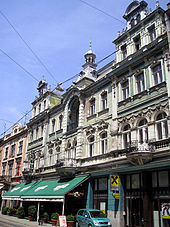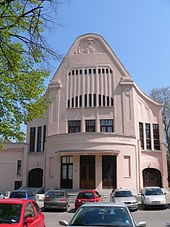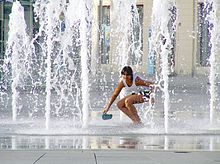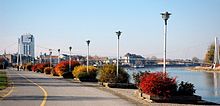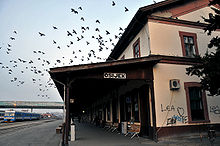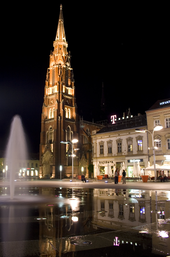- Osijek
-
"Mursa" redirects here. For the barbel species, see Luciobarbus mursa.
Osijek — City — City of Osijek
Grad OsijekCity of Osijek panorama 
Flag
Coat of armsNickname(s): Grad na Dravi (City on Drava) Osijek within Croatia Coordinates: 45°33′27.11″N 18°40′46.52″E / 45.5575306°N 18.6795889°ECoordinates: 45°33′27.11″N 18°40′46.52″E / 45.5575306°N 18.6795889°E Country Croatia County Osijek-Baranja County Government - Mayor Krešimir Bubalo (HDSSB) Area - City 30 km2 (11.6 sq mi) Elevation 94 m (308 ft) Population (2011)[1] - City 107,784 - Urban 83,496 Time zone CET (UTC+1) - Summer (DST) CEST (UTC+2) Post code 31000 Area code(s) 31 Licence plate OS Website OSIJEK.hr (English) Osijek (Croatian: Osijek, Croatian pronunciation: [ɔ̂sijɛ̝ːk]) is the fourth largest city in Croatia with a population of 83,496 in 2011.[1] It is the largest city and the economic and cultural centre of the eastern Croatian region of Slavonia, as well as the administrative centre of Osijek-Baranja county. Osijek is located on the right bank of the river Drava, 25 kilometres (16 mi) upstream of its confluence with the Danube, at an elevation of 94 metres (308 ft).
Contents
Name
The name was given to the city due to its position on elevated ground which prevented the city being flooded by the local swamp waters. Its name Osijek comes from the Croatian word "oseka" which means "ebb tide".
Due to its past and its history within the Habsburg Monarchy and briefly in the Ottoman Empire and also due to the presence of German and Hungarian minorities throughout its history, Osijek also has (or had) its names in other languages, notably Hungarian: Eszék, German: Esseg or Essegg, Latin: Mursa, Turkish: Ösek. All those names were adjusted variations to the original Croatian given name. In Roman times Osijek was called Mursa Maior, but its official Roman name was Colonia Aelia Mursa, as it was established by emperor Hadrian.
History
Origins
 St. Michael's Church, in Osijek's Baroque Tvrđa
St. Michael's Church, in Osijek's Baroque Tvrđa
The origins of human habitation of Osijek dates back to Neolithic times, with the first known inhabitants belonging to the Illyrian tribes. Roman emperor Hadrian raised the old settlement of Mursa to a colony with special privileges in 131. After that, Mursa had a turbulent history, with several decisive battles taking place (among which the Battle of Mursa Major in 351 and the battle between Aureolus and Ingenuus in 260), deciding the destiny of the whole region. After their migration, the Croats made a settlement near the ruins of Mursa, giving it its present name, Osijek. After the Hungarian settlements in Carpat basin, the population in Osijek mostly was Hungarian to the time of Ottoman occupation. The first mentioned of Osijek was in 1196 (forum Ezek et portas name). The ovner of the settlements market was the Abbey of Cikádor (now Bataszék in Hungary). Later mentioned in 1335 villa Ezeek, in 1352 possesio Ezek, in 1353 tributum fori in Ezeek et tributum portas fluvii Draue, 1454 opidium Ezek,1469 opidium Ezeek. The first mentioned of the fortress in 1472. (castellum Ezeek). Life was thriving here in the Middle Ages, but only traces of that life can be found today because of destruction in Ottoman–Hungarian Wars as well as architectural changes during the Ottoman period.
The earliest mentions of Osijek date to 1196.[2] The town was a feudal property of the Korogyi family between 1353 and 1472. After the died the last Korogyi, king Mathias grant it to the Rozgonyi family. But in 1493 his ovner is the Chapter of Holy Virgin in Buda (now Budapest).The city was damaged by the Ottoman conquerors on 8 August 1526.[2] The Turks rebuilt it in oriental style and it was mentioned in the Turkish census of 1579. In 1566, Suleiman the Magnificent built a famous, 8 kilometer-long wooden bridge of boats in Osijek, considered to be one of the wonders of the world.[3] The town was officially promoted to a city by the end of the 17th century. It was a sanjak of Budin Eyalet.
Habsburg Empire
Osijek was restored to western rule when on 29 September 1687 the Turks were kicked out and it became occupied by the Habsburg Empire.[4] Between 1712 and 1721, new Austrian authorities built a new fortress (authored by the architect Maximilian de Gosseau), known as Tvrđa.[5] It is a unique urban and military complex that lies in the heart of the town. Its main central Holy Trinity Square is closed on the north by the building of the Military Command, on the west there is the Main Guard building and on the east is the Magistrate building (presently Museum of Slavonia). In the middle there is a monument to the plague, erected in 1729 by general Petras' widow.[6] The Gornji Grad (Upper Town) was founded in 1692 and Donji Grad (Lower Town) followed on 1698. Tvrđa, Gornji, and Donji grad continued as separate municipalities until 1786. In late 18th century it took over from Virovitica as the centre of the Verőce county.
The Habsburg empire also facilitated the migration and settlement of German immigrants into the town and region.
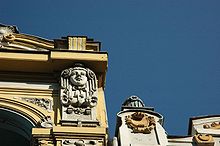 Secessionist architecture
Secessionist architecture
In 1809, Osijek was granted the title of a Free Royal City and during the early 19th century it was the largest city in Croatia.[3] The city developed along the lines of other central European cities, with cultural, architectural and socio-economic influences filtering down from Vienna and Buda.
During the 19th century, cultural life mostly revolved around the theatre, museums (the first museum, Museum of Slavonia was opened in 1877 by private donations), collections and printing houses (the Franciscans).[7] City society, whose development was accompanied by a prosperous economy and developed trade relations, was related to religious festivals, public events (fairs), entertainment and sports. The Novi Grad (New Town) section of the city was built in the 19th century, as well as Retfala to the west.
20th century
The newest additions to the city include Sjenjak, Vijenac, Jug and Jug II, which were built in the 20th century. The city's geographical riverside location, and noted cultural and historical heritage — particularly the baroque Tvrđa, one of the most immediately recognizable structures in the region — facilitated the development of tourism. The Osijek oil refinery was a strategic bombing target of the Oil Campaign of World War II.[8]
Immediately after the war, the daily newspaper Glas Slavonije has been relocated to Osijek and has printed there ever since. A history archive was established in the city in 1947 and city library in 1949. The Children's theatre and the art gallery were open in 1950.
As a continuation of the reach tradition of promoting national heritage, especially in music, society of culture and art "Pajo Kolarić" was established on 21 March 1954.[9]
Osijek has been connected with the Croatian republic's capital Zagreb and the previous federal capital Belgrade by a modern paved road since 1958. The new Drava bridge to the north was built in 1962.
The first faculty opened in Osijek was Faculty of Economy (in 1959 as Centre for economic studies of the Faculty of Economy in Zagreb),[10] followed immediately by a high school of agriculture, later renamed as Faculty of Agriculture[11] and Faculty of Philosophy.[12] The Faculty of Law was established in 1975.[13] thus becoming the first new member of newly established University of Osijek.
As part of further development as a regional food industry and agricultural centre, a major (working) collective for agriculture and industry was established in 1962.
During 1980s, a new pedestrian suspension bridge over the Drava was built. A regional centre of JRT was also opened.
During the war in Croatia, from 1991 to 1995, the city avoided heavy destruction (unlike nearby Vukovar, for example) and sustained moderate damage, especially to the centre and Co-cathedral of St. Peter and St. Paul[14] and to the periphery. More than a thousand (over 1200)[citation needed] civilians also died in the daily shelling of the town. On the other hand, at least five Croatian officials were condemned for war crimes against Serb civilians in Osijek, including General Branimir Glavaš.[15] While some buildings still have mild damage, most often the occasional superficial pockmark from artillery and mortar fire, the city's façades are generally in good shape, due to extensive restoration in recent times, preserving the charm of its intricate Austro-Hungarian Baroque architecture in the older quarters of town.
Climate
Climate data for Osijek Month Jan Feb Mar Apr May Jun Jul Aug Sep Oct Nov Dec Year Average high °C (°F) 2.6
(36.7)5.5
(41.9)11.7
(53.1)17.3
(63.1)22.4
(72.3)25.6
(78.1)28.0
(82.4)27.6
(81.7)23.5
(74.3)17.3
(63.1)9.8
(49.6)4.4
(39.9)16.31
(61.35)Average low °C (°F) −4.2
(24.4)−2.9
(26.8)1.2
(34.2)5.7
(42.3)10.4
(50.7)13.5
(56.3)15.0
(59.0)14.4
(57.9)10.9
(51.6)6.2
(43.2)2.2
(36.0)−1.5
(29.3)5.91
(42.63)Precipitation mm (inches) 45.5
(1.791)41.8
(1.646)45.3
(1.783)59.8
(2.354)69.2
(2.724)81.8
(3.22)60.8
(2.394)57.6
(2.268)54.3
(2.138)60.1
(2.366)61.3
(2.413)54.7
(2.154)692.2
(27.252)Avg. precipitation days 12 11 12 13 13 13 10 9 9 10 13 14 139 Source: World Meteorological Organisation (UN) [16] Population
According to the 1910 census, the city had 31,388 inhabitants. One source lists 12,625 as Croats, 11,269 as Germans or Danube Swabians, 7,500 as Jews, and 3,729 as Magyars,[17] but note that these figures sum to more than the total population. After World War II a large part of the Danube Swabian population were expelled as a revenge for their participation in German occupation of Yugoslavia. Their property has become publicly owned and redistributed to the World War II victims.
According to the 1981 census, the total population had reached 158,790, including 90,770 (57.16%) Croats and 28,536 (17.97%) Serbs.[citation needed]
Prior to the Croatian War of Independence, the 1991 census recorded a total population of 165,253, composed of 110,934 (67.1%) Croats, 33,146 (20.0%) Serbs, 3,156 (1.9%) Hungarians, 276 (0.16%) Germans, and 17,741 (10.7%) people categorised as Yugoslavs or 'others'.[citation needed]
According to the census of 2001, total population of Osijek dropped to 114,616. Croats made up the majority of Osijek's citizens, comprising 86.58 per cent of the city's population. Other ethnicities include 8,767 (7.65%) Serbs, 1,154 (1.01%) Hungarians, 480 (0.42%) Albanians, 211 (0.18%) Bosniaks, 175 (0.15%) Montenegrins, 178 (0.16%) ethnic Macedonians, 124 (0.11%) Roma, and others including 24 Jews.[18]
Osijek's population includes 96,600 (84.28%) Roman Catholics, 78 (0.07%) Eastern-rite Catholics, 8,619 (7.52%) Orthodox Christians, and 966 (0.84%) Muslims and others.[citation needed]
In the census of 2011, the following settlements were recorded:[1]
Institutions and industries
Major institutions in the city include the Josip Juraj Strossmayer University of Osijek (established in 1975), the Croatian National Theatre, the Museum of Slavonia (established in 1877), and the printing house dating to 1735. The city also has several gymnasiums, the oldest of which dates to 1729, a drawing school from the 19th century, a zoological garden, a centre for the promotion of livestock breeding, and an institute for sugar beet farming.
The Saponia chemical factory is the largest factory located in the Osijek area. It is a major producer of detergents, soap and cosmetics whose products are recognized throughout the region as being of quality.[19] It is by far the largest exporter in the city area. Other industries include a regional brewery, the Pivovara Osijek (first Croatian beer), and a sugar processing plant.
The Osijek area used to be much more industrialised and a broad range of goods and products were being manufactured there. One of the earliest factories was the Drava match factory, established in 1856, which no longer exists.[20] Other industries included production of synthetic materials, agricultural machinery, metal furniture, wood and timber, textiles, footwear, and silk, as well as metal processing and printing. However, the 1990s saw most of these industries decline and in some cases close completely. However, the city remains at the centre of an important agricultural region.
Politics
At the November 2007 elections, no party held a majority, which is not unusual for Croatia as local elections have proportional representation. However, the three mathematically possible coalitions had political problems that made coalition building unusually difficult. The November elections were early (izvanredne) elections caused by the breakdown of the coalition of the two main parties, the Croatian Party of Rights (HSP) and the Croatian Democratic Assembly of Slavonia and Baranja (HDSSB). The cause of the breakdown was disagreement over the building of a new sports stadium.[21][22]
At the elections held on the 25 November 2007, the Croatian Party of Rights (HSP) and the Croatian Democratic Assembly of Slavonia and Baranja (HDSSB) gained 7 seats each, the Social Democratic Party (SDP) 6 seats, the Croatian Democratic Union (HDZ) 4, and the Croatian People's Party – Liberal Democrats (HNS) 1.[23] A possible coalition between HDSSB and SDP provoked criticism of the Social Democrats for lack of principle such as from Damir Kajin, who called it a 'sellotape coalition', alluding to the charges of war crimes that the HDSSB leader Branimir Glavaš is facing.[24]
After the parties failed to agree a coalition, the Croatian government called new elections for the city.[22] These elections took place on 9 March 2008 and gave the Croatian Party of Rights 9 councilors, the Croatian Democratic Assembly of Slavonia and Baranja 6, HDZ, 5, SDP, 3 and a coalition of HNS and two smaller parties 2. Anto Đapić has expressed his hope for a coalition with the HDZ.[25]
Society and culture
Cultural events
Numerous events take place in the city throughout the year. The most important of them are the Croatian Tambura Music Festival (in May), attended by tambura orchestras from all over Croatia and the Osijek Summer Nights (during June, July and August), a series of cultural and entertainment programs in the open, accompanied by excellent food and fairs. The Day of the City of Osijek is celebrated with a cultural and artistic activities and exhibitions.
The surroundings of Osijek provide opportunities for hunting and angling on the Drava river and its backwaters. Hunting in the area known as Kopački Rit (in Baranja) is famous beyond the borders of Croatia.
Cuisine
The abundance of game and agriculture has made Osijek the country's semi-official gastronomical capital. Local dishes include traditional Slavonian-style specialities (kulen, paprika-flavoured sausage, other kinds of sausages, ham, bacon, dairy products), as well as venison and fish dishes such as the famous riblji paprikaš (fish stew made with paprika). Two brands of beer are brewed in Osijek: Osječko and Esseker. There is also the Baranja wine offered in restaurants.
Sports
The recreational and sports centre Copacabana, opened in 1980, located on the left bank of the Drava river, provides opportunities for various water sports (outdoor swimming pools and a sand beach with various facilities) during the summer months. The city offers various playgrounds: football, handball, basketball, tennis courts, etc. NK Osijek are the city's main football team,which are followed by their supporters group called Kohorta Osijek, playing in the Croatian First League at Gradski vrt stadium. The city is also home to a number of smaller teams including NK Grafičar Vodovod and NK Metalac. Before the Second World War, the city's most successful club was Slavija Osijek, which collapsed in 1941. A new sports hall (Dvorana Gradski vrt) was built as the 2009 World Men's Handball Championship venue. Osijek also hosts an extreme sports contest Pannonian challenge which features competitions in skateboarding, inline skating, freestyle BMX and MTB dirt racing.[26]
Tourism, sights and attractions
Osijek remains a popular domestic tourist destination for its Baroque style, open spaces and ample recreational opportunities. The most important sights in the city include the main square, Trg Ante Starčevića, Tvrđa the 18th century Baroque citadel, the promenade along the Drava ("promenada"), and the suspension pedestrian bridge toward Baranja.
The Municipal Park of King Petar Krešimir IV and the Tomislav Park date from the beginning of the 20th century, and are protected national landmarks. Osijek is also home to one of the few Croatian zoological gardens, along the Drava river. The city is home to a monument to Ante Starčević.[27]
The Co-cathedral of St. Peter and Paul (Sv. Petar i Pavao) is a Neo-Gothic structure with the second highest tower in Croatia after the Zagreb Cathedral. The tower measure 90 m (295.28 ft) and can be seen from throughout Osijek. Because of its size most locals refer to it as the cathedral but it is only a parish church. The Church of St Peter and St Paul was designed by Franz Langenberg and contains 40 stained glass windows, although they are not all intact after the bombing in the 1990s. The church also contains sculptures by Eduard Hauser.

A panoramic view of the pedestrian bridge over the Drava Transport
See also: Osijek tram systemTransport links to and from Osijek include major railway and highway junctions, a river port, and Osijek Airport. International flights from the airport to Cologne/Bonn Airport in Germany commenced in March 2008.[28] A four-lane highway, part of the Pan-European Corridor Vc, linking Osijek to the rest of the Croatian modern highway network, was completed and opened in April 2009. From Osijek, it is possible to take the train to numerous destinations including Zagreb, Rijeka, Požega, Virovitica, Našice, Slavonski Brod, Slavonski Šamac, Erdut, Vrpolje, Dalj, Đakovo, and Beli Manastir, from where there are connections on to Hungary. There is also a daily service from Budapest to Sarajevo that stops in Osijek.
A small tram network runs through the city, which has been in continuous operation since 1884 and is the only tram network still in operation in Croatia outside of Zagreb. The network is currently being completely overhauled and more than doubled in length, and the city's old trams have been thoroughly modernized.
Famous people from Osijek
Main article: List of people from OsijekFamous people who were born or have lived in Osijek include Matija Petar Katančić, an 18th century Croatian writer, professor of archaeology, translator of the Bible into Croatian, and author of the first paper over the archaeology in Croatia), Josip Juraj Strossmayer, a Croatian Maecenas bishop, Franjo Šeper, Archbishop of Zagreb from 1960–1968, and Prefect of the Congregation for the Doctrine of the Faith from 1968–1981, Francis, Duke of Teck, a German prince and father of Mary of Teck (later the Queen Consort of George V) hence the great grandfather of Queen Elizabeth II, painters Adolf Waldinger and Bela Čikoš Sesija, musicians Franjo Krežma, Miroslav Škoro, Branko Mihaljević and Krunoslav Slabinac, historian Ferdo Šišić, TV journalist Vladimir Herzog, Hollywood producer Branko Lustig, footballers Davor Šuker and Franjo Glaser, sport shooter Jasna Šekarić and tennis player Jelena Dokić. Nobel Prize winners Lavoslav (Leopold) Ružička and Vladimir Prelog also lived in the city, as did meteorologist and seismologist Andrija Mohorovičić, and world known mathematician and climatologist Milutin Milanković.
International relations
See also: List of twin towns and sister cities in CroatiaTwin towns - sister cities
References
Bibliography
- Cresswell, Peterjon; Atkins, Ismay; Dunn, Lily (10 July 2006). Time Out Croatia (First ed.). London, Berkeley & Toronto: Time Out Group Ltd & Ebury Publishing, Random House Ltd. 20 Vauxhall Bridge Road, London SV1V 2SA. ISBN 978-1-904978-70-1. http://books.google.com/books?id=VZweAAAACAAJ. Retrieved 10 March 2010.
Notes
- ^ a b c "Census of Population, Households and Dwellings 2011, First Results by Settlements - County of Osijek-Baranja - Osijek" (in Croatian and English) (HTML). Statistical Reports (Zagreb: Croatian Bureau of Statistics) (1441). June 2011. ISSN 1332-0297. http://www.dzs.hr/Eng/censuses/census2011/htm/E11_Zup25_3123.html. Retrieved 2011-09-02.
- ^ a b Stallaerts, Robert (28 February 2010). Historical dictionary of Croatia. Scarecrow Press. p. 239. ISBN 978-0-8108-6750-5. http://books.google.com/books?id=NSjRbIz4iDkC&pg=PA239. Retrieved 15 October 2011.
- ^ a b Dorling, Kindersley; Zopp, Leandro (6 June 2011). DK Eyewitness Travel Guide: Croatia. Dorling Kindersley Ltd. p. 189. ISBN 978-1-4053-6071-5. http://books.google.com/books?id=KTFWUPUEo7YC&pg=PA189. Retrieved 15 October 2011.
- ^ Bousfield, Jonathan (July 2003). Rough guide to Croatia. Rough Guides. p. 126. ISBN 978-1-84353-084-8. http://books.google.com/books?id=UxSnm-mUp40C&pg=PA126. Retrieved 15 October 2011.
- ^ Oliver, Jeanne (15 March 2005). Croatia. Lonely Planet. p. 85. ISBN 978-1-74059-487-5. http://books.google.com/books?id=q89-gjhzsxAC&pg=PA85. Retrieved 15 October 2011.
- ^ Olson, Karen Tormé; Olson, Sanja Bazulic (14 April 2006). Frommer's Croatia. Frommer's. p. 307. ISBN 978-0-7645-9898-2. http://books.google.com/books?id=2v2ECnZpt9oC&pg=PA307. Retrieved 15 October 2011.
- ^ Demo, Željko (1994). Ostrogothic coinage from collections in Croatia, Slovenia and Bosnia & Herzegovina. Narodni Muzej. http://books.google.com/books?id=u3BpAAAAMAAJ. Retrieved 15 October 2011.
- ^ Raiford, Neil Hunter (October 2004). Shadow: a Cottontail bomber crew in World War II. McFarland. p. 181. ISBN 978-0-7864-1906-7. http://books.google.com/books?id=V6nuRQp1LzQC&pg=PA181. Retrieved 15 October 2011.
- ^ http://www.pajo-kolaric.hr/
- ^ "Ekonomski fakultet u Osijeku | EFOS - Povijest fakulteta". Efos.hr. http://www.efos.hr/index.php?option=com_content&task=view&id=258&Itemid=152. Retrieved 2011-09-16.
- ^ "Poljoprivredni fakultet u Osijeku". Pfos.hr. http://www.pfos.hr/index.php?option=com_content&view=article&id=15&Itemid=19. Retrieved 2011-09-16.
- ^ "Filozofski fakultet u Osijeku". Web.ffos.hr. http://web.ffos.hr/?id=4. Retrieved 2011-09-16.
- ^ "Faculty Of Law In Osijek - Content". Pravos.hr. 2007-11-26. http://www.pravos.hr/english/modules.php?name=Content&pa=showpage&pid=1. Retrieved 2011-09-16.
- ^ Župna crkva Sv. Petra i Pavla Apostola u Osijeku
- ^ Former war mayor Branimir Glavas is sentenced on 9 years of jail and he is war criminal fugitive now. Osječka Hvidra osudila uhićenje svojih članova (Croatian)
- ^ "World Weather Information Service – Osijek". United Nations. http://www.worldweather.org/019/c00071.htm. Retrieved 20 January 2011.
- ^ László Zentai and Pál Kósa (eds.) Talma Kiadó Atlas and Gazetteer of Historic Hungary 1914, Talma Kiadó, 2001
- ^ Population by ethnicity, by towns/municipalities, census 2001, Croatian Bureau of Statistics, accessed 13 January 2008
- ^ Sharma, Soumitra (1997). Restructuring Eastern Europe: the microeconomics of the transition process. Edward Elgar Publishing. p. 144. ISBN 978-1-85898-576-3. http://books.google.com/books?id=mt5qCckuwd0C&pg=PA144. Retrieved 15 October 2011.
- ^ Yugoslavia. Komisija za Ekonomsku Historiju Jugoslavije (1 January 1985). Acta historico-oeconomica Iugoslaviae: časopis za ekonomsku povijest Jugoslavije. Komisija za ekonomsku historiju Jugoslavije. http://books.google.com/books?id=F-TsAAAAMAAJ. Retrieved 15 October 2011.
- ^ Šutnja u Osijeku
- ^ a b "Government calls early elections in Osijek for 9 March". Government of the Republic of Croatia. 2008-01-24. http://www.vlada.hr/en/naslovnica/novosti_i_najave/2008/sijecanj/vlada_izbori_u_osijeku_9_ozujka. Retrieved 2008-03-10.
- ^ Osijek: Pokušaj riješavanja krize, Hrvatska radiotelevizija, 26 December 2007, accessed 13 January 2008
- ^ IDS osuđuje trgovinu Vlade i Osijeka, Hrvatska radiotelevizija, 21 December 2007, accessed 13 January 2008
- ^ HSP najjači u Osijeku
- ^ Karmen Horvat (2007-11-23). "Osijek sports hall construction contract signed". Javno.com. http://www.javno.com/en/croatia/clanak.php?id=100819. Retrieved 2008-03-23.
- ^ "Osječani rekli "Da" spomeniku Ocu Domovine - na glavnom trgu otkriven spomenik dr. Anti Starčeviću". City of Osijek. 2007-06-13. http://www.osijek.hr/nastavak.aspx?id=8339. Retrieved 2008-08-28.[dead link]
- ^ "First international flight departs from Osijek International Airport". Osijek Airport. 2008-03-14. Archived from the original on 2008-05-20. http://web.archive.org/web/20080520120418/http://www.osijek-airport.hr/en/novosti/danas-polijecemo.html. Retrieved 2008-03-23.
- ^ "Sister cities". City of Osijek. http://www.osijek.hr/beta/index.php/eng/content/view/full/3366. Retrieved 29 August 2010.
External links
- Wikitravel Osijek site
- Osijek 031 city portal
- Osijek Online
- Osijek tourist information
- (English) Spring, Zvonko (1999). "Osijek - Essek - Mursa: My hometown for more than 74 years". CroatianHistory.net. http://www.croatianhistory.net/etf/osijek.html. Retrieved 2009-10-13.[specify]
Osijek History Buildings and
landmarksAnte Starčević Square · Esseker Center · Eurodom · European Avenue · PortanovaChurches Culture Croatian National Theatre in Osijek · Branko Mihaljević Children's Theatre · City and University LibraryGalleries and
museums-Education University of Osijek (Academies: Art · Faculties: Agriculture · Civil Engineering · Economics and Business · Electrical Engineering · Evangelical Theological Seminary · Food Technology · Humanities and Social Sciences · Law · Medicine · Teacher Education)Sports venues Transport Festivals Urban Fest OsijekDistricts of Osijek Tvrđa · Donji grad · Gornji grad · Retfala · Novi grad · Industrijska četvrt
Cities and major settlements of Croatia by population 100,000+ 35,000+ 10,000+ Beli Manastir · Belišće · Benkovac · Čakovec · Crikvenica · Đakovo · Daruvar · Duga Resa · Dugo Selo · Garešnica · Gospić · Imotski · Ivanec · Ivanić-Grad · Jastrebarsko · Kastav · Knin · Koprivnica · Krapina · Križevci · Kutina · Labin · Makarska · Metković · Našice · Nova Gradiška · Novi Marof · Novska · Ogulin · Omiš · Opatija · Petrinja · Pleternica · Ploče · Poreč · Požega · Rovinj · Sinj · Slatina · Solin · Sveta Nedelja · Sveti Ivan Zelina · Trogir · Umag · Valpovo · Virovitica · Vrbovec · Vukovar · Zaprešić · ŽupanjaSubdivisions of Osijek-Baranja County Cities and towns Municipalities Antunovac · Bilje · Bizovac · Čeminac · Čepin · Darda · Donja Motičina · Draž · Drenje · Đurđenovac · Erdut · Ernestinovo · Feričanci · Gorjani · Jagodnjak · Kneževi Vinogradi · Koška · Levanjska Varoš · Magadenovac · Marijanci · Petlovac · Petrijevci · Podgorač · Podravska Moslavina · Punitovci · Satnica Đakovačka · Semeljci · Strizivojna · Šodolovci · Trnava · Viljevo · Viškovci · Vladislavci · VukaCategories:- Populated places in Osijek-Baranja County
- Cities and towns in Croatia
- Oil Campaign of World War II
Wikimedia Foundation. 2010.



